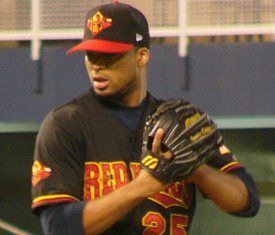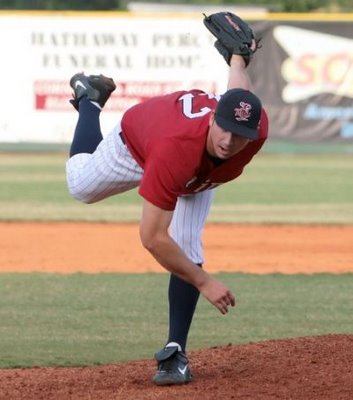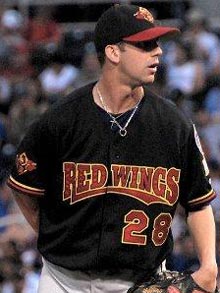November 5, 2008
Twins 2008 Minor League Numbers: Pitchers
Evaluating pitchers is typically more difficult than evaluating hitters, because pitchers rely heavily on the defense behind them. Beyond that, pitchers often exit games with runners on base and whether or not those runners score off the pitcher who comes in from the bullpen can have a big impact on ERAs and win-loss records. All of which is why, rather than looking at more traditional stats, my focus is instead on a metric called Fielding Independent Pitching (FIP).
Designed to look just like ERA--the MLB average was right around 4.35 this year--FIP measures only things that a pitcher is individually responsible for, including strikeouts, walks, and homers. The idea is to remove the impact of the defense behind them, the pitchers who relieve them, and any luck involved. After calculating FIPs for each of the Twins' minor-league pitchers, the next step is to adjust the totals based on the system's various run-scoring environments.
From Rochester and New Britain to Fort Myers and Beloit, the Twins' minor-league system is filled with low run-scoring environments. That makes hitting prospects look worse and pitching prospects look better, and in both cases the end result is misleading raw numbers. However, accounting for that and normalizing the run-scoring environments to fit the level of offense in MLB paints a far clearer picture. Basically, the adjustments put everyone on an even playing field before evaluating their performance.
 Tons of pitchers in the Twins' minor-league system post ERAs in the 3.00s and 4.00s every year, but many of them do so while being below average at preventing runs because their league was such a low-scoring environment. MLB as a whole had a 4.32 ERA in 2008, while the four full-season leagues in the Twins' system averaged a 3.95 ERA. You're bound to post pretty ERAs when offensive levels are 10 percent below MLB, which is why run-scoring adjustments are important.
Tons of pitchers in the Twins' minor-league system post ERAs in the 3.00s and 4.00s every year, but many of them do so while being below average at preventing runs because their league was such a low-scoring environment. MLB as a whole had a 4.32 ERA in 2008, while the four full-season leagues in the Twins' system averaged a 3.95 ERA. You're bound to post pretty ERAs when offensive levels are 10 percent below MLB, which is why run-scoring adjustments are important.
Before getting to the good stuff, please note that these are not my rankings of the Twins' top prospects. That annual list will be published later this offseason and includes both multi-year track records and long-term potential as huge factors, whereas the numbers below focus solely on what each player did this year. The point here is to simply determine who had the best 2008 season by putting everyone's numbers through the same context-adjusting system. Here are the adjusted FIPs:
100+ INNINGS FIP 70-99 INNINGS FIP 40-69 INNINGS FIP
Francisco Liriano 3.26 Anthony Slama 1.33 Robert Delaney 2.38
Mike McCardell 3.38 Daniel Osterbrock 2.59 Michael Munoz 2.50
Jeff Manship 3.51 Bobby Korecky 3.05 Ben Julianel 3.00
David Bromberg 3.54 Charles Nolte 3.49 Angelo Sanchez 3.61
Santos Arias 3.87 Bobby Lanigan 3.55 Edgar Ibarra 3.63
Cole DeVries 3.88 Tyler Robertson 3.61 Blair Erickson 3.66
Steve Hirschfeld 3.99 Ricky Barrett 3.68 Jose Lugo 3.80
Matthew Fox 4.00 Zach Ward 3.92 Shooter Hunt 3.87
Michael Tarsi 4.38 Bradley Tippett 4.01 Mariano Gomez 3.88
Kyle Aselton 4.39 Armando Gabino 4.08 Martire Garcia 4.32
Kevin Mulvey 4.46 Matthew Williams 4.17 Carmen Cali 4.33
Alex Burnett 4.61 Spencer Steedley 4.41 Tim Lahey 4.52
Anthony Swarzak 4.70 Jason Miller 4.47 Thomas Wright 4.76
Oswaldo Sosa 4.87 Daniel Berlind 5.44 Curtis Leavitt 5.05
Brian Duensing 4.88 Julio DePaula 5.61 Casey Daigle 5.07
Ryan Mullins 4.97 Jay Sawatski 5.14
Yohan Pino 5.07 Loek Van Mil 5.65
Danny Graves 5.17 Brian Kirwan 5.69
Philip Humber 5.34 Frank Mata 5.75
Jay Rainville 5.34 Henry Reyes 6.42
Deolis Guerra 5.89
It's great to see Francisco Liriano atop the list of best FIPs from pitchers with 100-plus innings and his 3.26 adjusted FIP at Triple-A jives with the 3.87 FIP he had in Minnesota. Even if he were just another 24-year-old prospect with those numbers, Twins fans would have every right to be excited about his long-term potential. Of course, prior to Tommy John surgery Liriano had a 2.44 FIP between Double-A and Triple-A in 2005 and a 2.55 FIP for the Twins in 2006, so he's still a long way from that dominance.
Deolis Guerra is sadly at the other end of the performance spectrum, ranking dead last in adjusted FIP among pitchers with 100-plus innings. Acquired from the Mets last winter as the co-centerpiece of the Johan Santana trade, Guerra spent the year at high Single-A despite being a teenager and had a 5.47 ERA with a 71-to-71 strikeout-to-walk ratio in 130 innings. He won't be 20 until April and wouldn't have been at high Single-A if the Mets hadn't misguidedly rushed him before the deal, but 2008 wasn't pretty.
As a reliever in the low minors Robert Delaney failed to crack my Top 40 Twins Prospects list for 2008 despite posting the second-best adjusted FIP in the system last year, but back-to-back seasons with a sub-2.40 FIP makes it safe to say that he's for real. Delaney was undrafted out of college, but saved 18 games with a 1.23 ERA and 72-to-11 strikeout-to-walk ratio in 66 innings this year--including thriving at Double-A as a 23-year-old--and has a 1.91 ERA and 185-to-28 strikeout-to-walk ratio for his career.
Amazingly, Delaney didn't even have the best adjusted FIP among Twins relief prospects this season. In fact, it wasn't close. Anthony Slama posted one of the most ridiculous pitching lines you'll ever see with a 1.01 ERA, 110-to-24 strikeout-to-walk ratio, zero homers allowed, and a .173 opponent's batting average in 71 innings at high Single-A. Equally amazing is that despite Slama being 24 years old and absolutely overpowering Florida State League hitters, the Twins inexplicably refused to promote him.
 Instead of seeing what he could do at Double-A against players his own age, Slama was left to rack up absurdly good numbers by dominating younger competition. Slama's season was incredible no matter how you look at it, but pitching against prospects 2-3 years his junior certainly takes some of the air out of his performance. As for how much, that's where adding to adjustments for run-scoring environments by factoring in both age and level of competition comes into play:
Instead of seeing what he could do at Double-A against players his own age, Slama was left to rack up absurdly good numbers by dominating younger competition. Slama's season was incredible no matter how you look at it, but pitching against prospects 2-3 years his junior certainly takes some of the air out of his performance. As for how much, that's where adding to adjustments for run-scoring environments by factoring in both age and level of competition comes into play:
AGE LEVEL FIP%
Anthony Slama 24 A+ 2.98
Robert Delaney 23 A+/AA 1.79
Michael Munoz 19 RK- 1.74
Daniel Osterbrock 21 RK+ 1.60
Francisco Liriano 24 AAA 1.34
Tyler Robertson 20 A+ 1.32
David Bromberg 20 A- 1.29
Bobby Korecky 28 AAA 1.22
Jeff Manship 23 A+/AA 1.21
Angelo Sanchez 19 RK- 1.21
Edgar Ibarra 19 RK- 1.20
Charles Nolte 22 A- 1.19
Ben Julianel 28 AA 1.19
Mike McCardell 23 A- 1.17
Bobby Lanigan 21 RK+ 1.17
Santos Arias 21 A- 1.12
Blair Erickson 23 A-/A+ 1.11
Bradley Tippett 20 RK+/A- 1.11
Shooter Hunt 21 RK+/A- 1.10
Mariano Gomez 25 AAA 1.08
Cole DeVries 23 A+ 1.07
Matthew Williams 21 A-/A+ 1.07
Zach Ward 24 AA 1.06
Martire Garcia 18 RK- 1.06
Ricky Barrett 27 AAA 1.05
Jose Lugo 24 A+ 1.05
Steve Hirschfeld 22 A- 1.04
Alex Burnett 20 A+ 1.04
Armando Gabino 24 AA 1.02
Kevin Mulvey 23 AAA 1.02
As you can see, even adjusting for run-scoring environment, level of competition, and age doesn't keep Slama from having by far the best season of any pitcher in the Twins' system. Docking him for being a 24-year-old at Single-A deflates his performance quite a bit, but there's only so much wind that can be taken out of the sails of a guy who faces 280 batters and strikes out 40 percent of them without giving up a homer. Liriano was very good and Delaney was great, but Slama was absolutely extraordinary.
After making the various adjustments, the Twins had a total of 30 pitchers who were above average in 2008, whereas 25 position players were above par. In terms of performances from MLB-ready pitchers, Liriano was 34 percent above average and will obviously be in the Twins' rotation next season. Bobby Korecky was 22 percent above par and at 28 years old has been deserving of a spot in the bullpen for a while now, while Mariano Gomez and Ricky Barrett also pitched well enough to be relief options.
 Kevin Mulvey joined everyone else in the Santana package by having a disappointing season, but after adjusting for context his performance was actually slightly above average for a 23-year-old starter at Triple-A. Unfortunately, the same can't be said for Philip Humber, who despite being two years older than Mulvey turned in the ninth-worst context-adjusted numbers of any pitcher in the Twins' system who logged 40-plus innings. Mulvey was disappointingly mediocre, but Humber was just plain awful.
Kevin Mulvey joined everyone else in the Santana package by having a disappointing season, but after adjusting for context his performance was actually slightly above average for a 23-year-old starter at Triple-A. Unfortunately, the same can't be said for Philip Humber, who despite being two years older than Mulvey turned in the ninth-worst context-adjusted numbers of any pitcher in the Twins' system who logged 40-plus innings. Mulvey was disappointingly mediocre, but Humber was just plain awful.
Tyler Robertson ranked No. 3 on my list of the Twins' best prospects coming into the season and was 32 percent above par as a 20-year-old at high Single-A before being shut down in July with shoulder problems. Jeff Manship and Mike McCardell added to their strong track records and continue to look like potential mid-rotation starters, while David Bromberg emerged as one of the Twins' top prospects in his first season above rookie-ball by rating 29 percent above average at low Single-A.
First-round pick Shooter Hunt had a strong pro debut, but seventh-round pick Daniel Osterbrock and third-round pick Bobby Lanigan made even better first impressions. As a 21-year-old with lots of major college experience Osterbrock was a man among boys at rookie-level Elizabethton, but even factoring in his age a 104-to-8 strikeout-to-walk ratio in 75 innings stands out 60 percent above average. Based on the very early results, the 2008 draft has been a success for both pitchers and hitters.
Once you're done here, check out my latest "Daily Dose" column over at Rotoworld.

